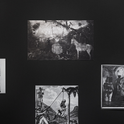There are some walls in my rented apartment the same colour as those in Vilhelm Hammershøi’s paintings. It’s a sort of very ghostly mauve, a strange shade of lavender that doesn’t even exist half the time. In my flat it disappears in bright daylight, only to reappear in the evening. It’s maybe for this reason I’ve come to think of it as a somewhat ominous, brooding colour.
Judging from the range of paintings Hammershøi did of his apartment on Strandgade in central Copenhagen, where he lived at the turn of the 20th century, his situation couldn’t have been further from my own; I doubt he had to put up with mould on the walls or a curmudgeonly landlord. Yet the foreboding quality of that colour still holds. His interiors are muted, even when light is blazing through an open window: so long as that mauve is visible, the light never seems to penetrate. When he adds solitary people into these dingy scenes, the result is something like dread.
My favourite of Hammershøi’s paintings—and admittedly perhaps his best known—is Interior with Young Woman Seen from the Back from 1903, depicting his wife Ida. Beside her is a dark wooden sideboard with an ornate China dish on top. In her hand is an empty silver tray. As the painting’s name suggests she has her back to us, as Hammershøi often liked to paint her. We’re under the impression she is just passing through—perhaps to the kitchen or dining room, to drop off the tray—or simply procrastinating. She is too close to the wall for her gaze to be on anything in particular: there is nothing to indicate the cause of her distraction other than what might be going on in her head. The shadows, like her gaze, all point towards the bottom corner of the painting. And backgrounding the entire scene is that doom-laden mauve.
Hammershøi’s paintings are frequently described in terms like “tranquil” and “calm”, but I’ve always thought there was something too fraught about them for that kind of wording. Ida is not at rest, and she doesn’t look relaxed. It’s not silence we’re looking at here but disquiet, of the sort only a staunchly bourgeois home could muster. Because where else do psychological horrors appear so stark, but in places where material comfort has long been taken for granted?
Nowadays when we think about Danish interiors, we most likely turn to mid-century modernism: airy white space, creamy shades of wood, abstract shapes and smooth lines, motifs we might find in the works of industrial designers like Arne Jacobsen. But the Danish obsession with what Gaston Bachelard might have called a shelter for daydreaming predates all of this by at least a century. By the 1820s, industrialisation had produced a new middle class in Denmark with the financial means to give patronage to artists. In a mirror of the aristocracy who dominated such patronage before them, this new class wished to see art that reflected their newfound status—which mostly amounted to a showcase of their property and cultural good taste. Typically the result was domestic scenes that were elaborately staged and full of action, such as in Wilhelm Bendz’s A Smoking Party from 1827.
By the time Hammershøi was making his best images of domesticity decades later, the homeliness and familiarity that pervaded the genre became something subtler and anxious, like a question whispered in the ear: is this all there really is? Is this what constitutes the good life? In today’s climate, when the middle class is not as well off as it once was—where no one but an elite few is as well off as they once were—I can’t help but think, as I return to my flat on a winter’s evening and see the mauve appear above the mottles of damp: it might not be everything. But what happens when you don’t have even that?














